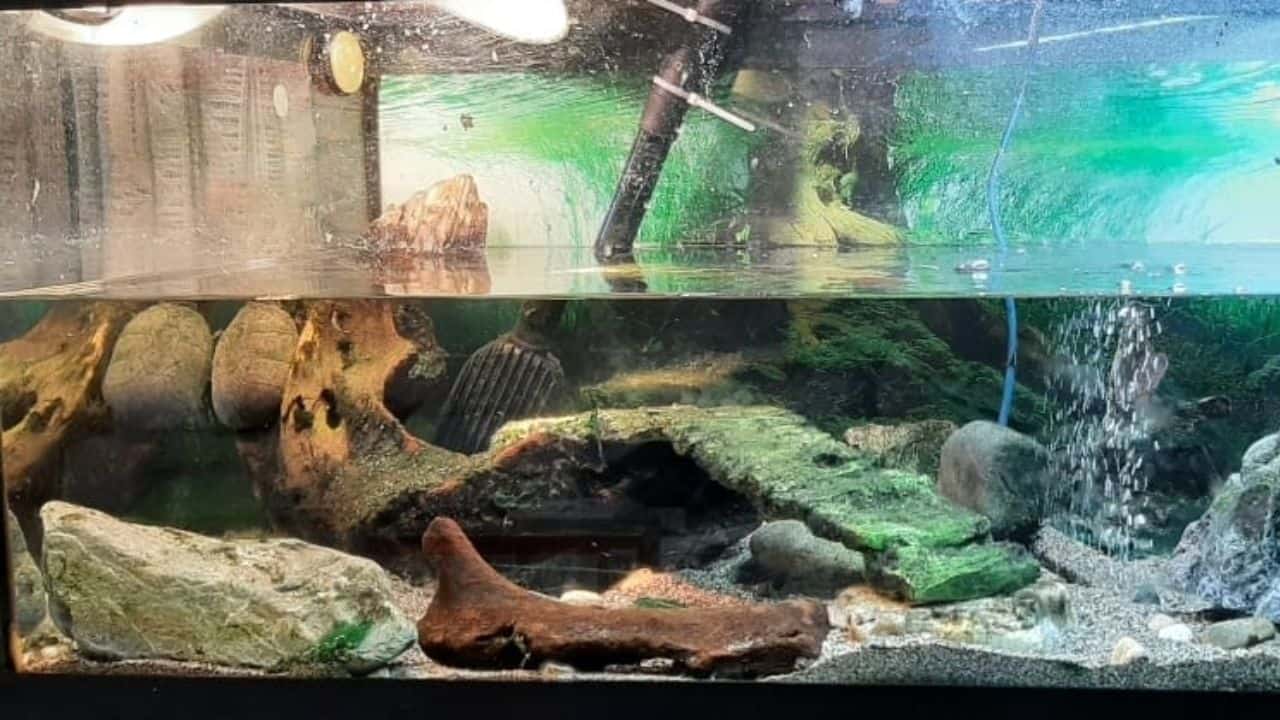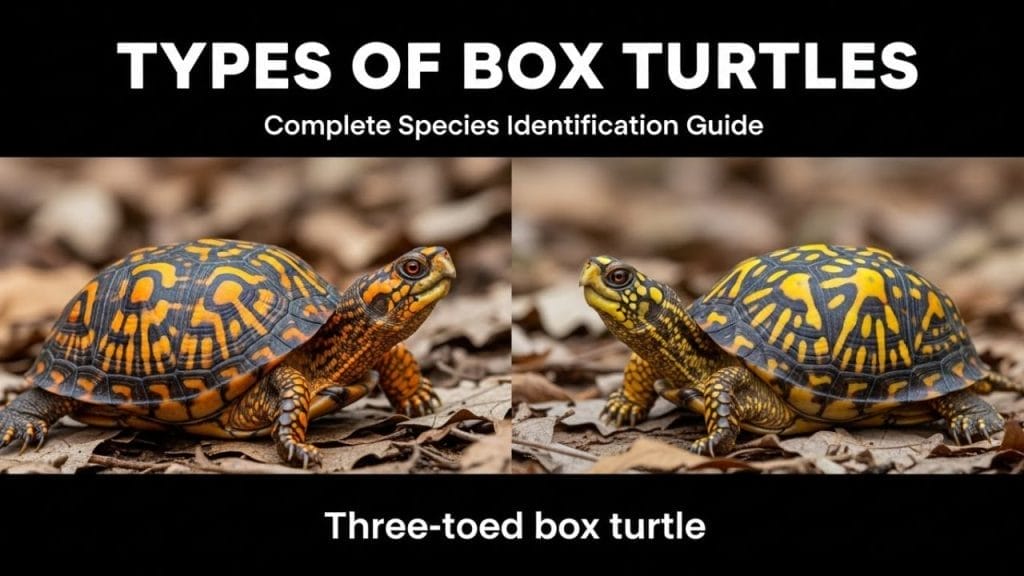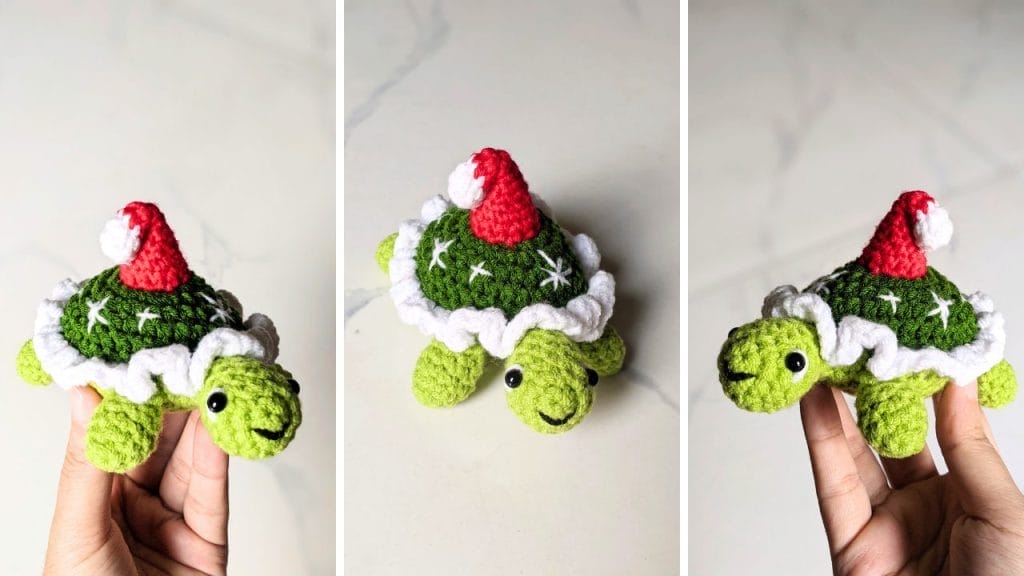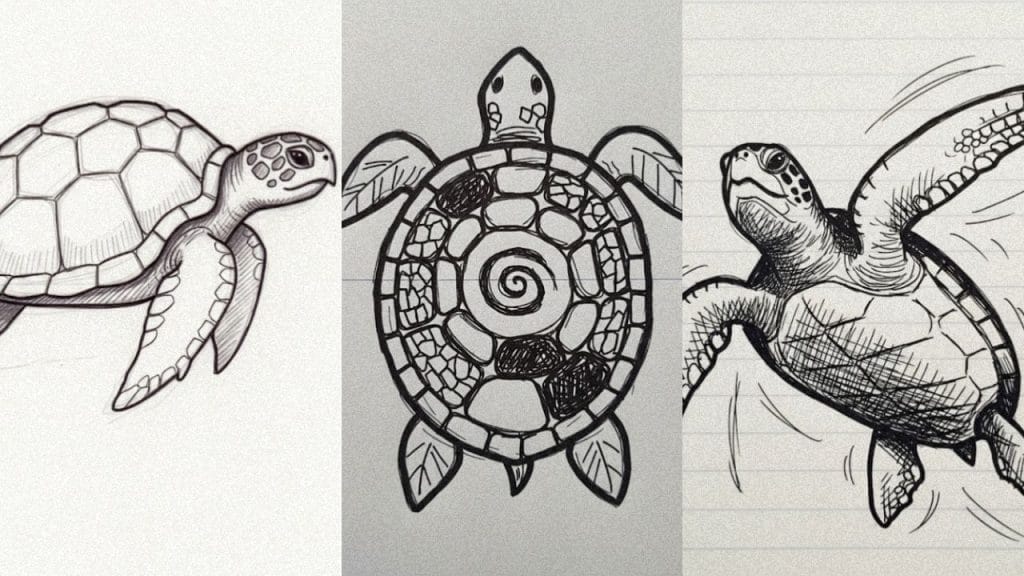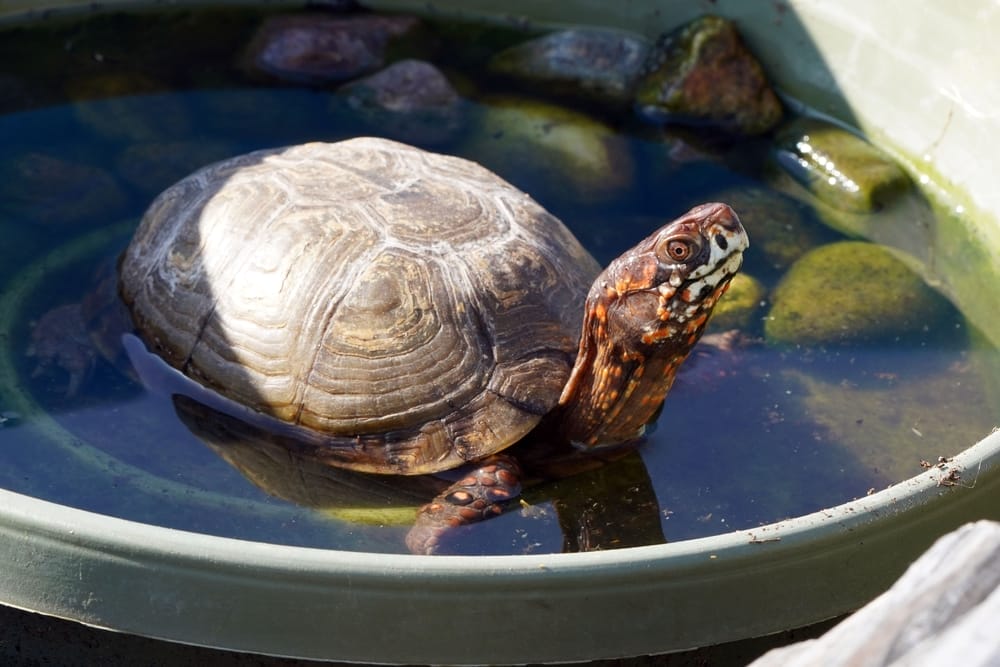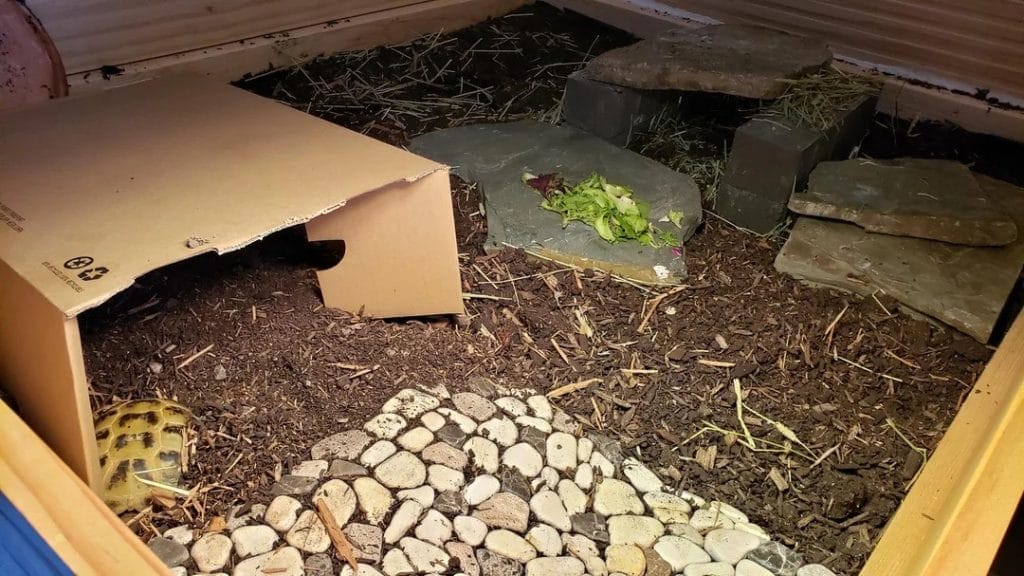Turtle Basking Lights 101: The Simple Setup Every Beginner Needs

This post was created with help from AI tools and carefully reviewed by a human (Muntaseer Rahman). For more on how we use AI on this site, check out our Editorial Policy.
When I got my first turtle, I thought setting up a basking area was as simple as sticking a heat lamp over the tank.
Spoiler alert: I was wrong.
After a few mistakes (and one very grumpy turtle), I finally figured out the right setup. If you’re just starting out, don’t worry—I’ve got you covered with this easy guide!
Before We Talk Lighting: The Brutal Truth
Here’s something nobody tells beginners: Perfect lighting won’t save a turtle in a bad setup.
I learned this the expensive way. I bought top-tier UVB bulbs, perfectly positioned my heat lamps, measured every distance with a ruler. My lighting was chef’s kiss.
But my turtle still got sick.
Why? Because my filter was undersized. My water was toxic. I was feeding garbage food. My turtle didn’t have enough swimming space.
The reality check: Lighting is critical, but it’s only 25% of what keeps your turtle healthy.
What your turtle actually needs:
- Proper lighting (you’re here, we’ve got this covered)
- Powerful filtration – Turtles produce 3-4x more waste than fish
- Adequate water heating – Separate from basking heat
- Quality nutrition – Commercial food + calcium supplements
- Water treatment – Conditioner and test kits
- Proper tank size – 10 gallons per inch of shell, minimum
Here’s what happens when you ONLY fix lighting:
- Great UVB + poor filtration = Shell rot from dirty water
- Perfect basking temp + wrong diet = Vitamin A deficiency
- Ideal lighting schedule + no water heater = Respiratory infection
Once you’ve set up your lighting (this guide has you covered), check our Complete Turtle Owner Essentials to make sure filtration, heating, nutrition, and water quality are also dialed in.
Specifically:
- Powerful canister filters – UVB doesn’t fix dirty water
- Water heaters – Basking heat alone isn’t enough
- Proper nutrition – UVB is useless without calcium supplements
- Water treatment – Clean water matters as much as good lighting
Now let’s get your lighting perfect.
Quick Start Guide (For Those in a Hurry)
I get it. You just want the basics without reading a novel. Here’s the quick and dirty guide to setting up the perfect basking light for your turtle.
What Lights Do You Need?
Your turtle needs two essential lights:
- UVB Light – Helps with vitamin D3 and strong shells
- Heat Lamp – Keeps them warm while basking
- (Optional) Night Light – Only if you want to watch them at night
Best Light Choices (Budget & Premium)
If you don’t want to spend hours comparing brands, here are my top picks.

Reptisun T5HO 5.0 Strip

Arcadia Basking Spot Light

MegaRay Mercury Vapor
| Type | Best Budget Option | Best Premium Option |
|---|---|---|
| UVB Bulb | XYZ Compact UVB 5.0 | Reptisun T5HO 5.0 Strip |
| Heat Lamp | Standard Incandescent | Arcadia Basking Spot |
| All-in-One | Mercury Vapor Lamp | MegaRay Mercury Vapor |
I personally love the Reptisun T5HO Strip. It covers a wider area, and my turtles bask like sunbathing royalty under it.
How Far Should Lights Be?
Yes, distance matters. Too close, and your turtle roasts. Too far, and they get nothing.
| Bulb Type | Distance from Turtle |
|---|---|
| 2.5% UVB | 12 inches |
| 5% UVB | 18 inches |
| Heat Lamp (50W) | 5–7 inches |
| Heat Lamp (100W) | 10–12 inches |
How Long Should They Stay On?
Turtles don’t need 24/7 lighting unless you’re trying to confuse them.
- Daytime (8–12 hrs): UVB & Heat Lamp ON
- Nighttime: All lights OFF (unless using a soft night lamp for baby turtles)
I use a timer plug to automate this. No need to remember to switch lights on and off every day.
Common Lighting Mistakes (Avoid These)
- Using the wrong UVB bulb – Stick to 2.5% or 5% for aquatic turtles
- Placing the light too far or too close – Follow the distance chart
- Forgetting to replace UVB bulbs – They lose effectiveness after 6 months
- Leaving heat lamps on all night – Turtles need darkness to rest
That’s it. If you follow these basics, your turtle will be basking happily in no time.
This Hilarious Turtle Book Might Know Your Pet Better Than You Do
Let’s be real—most turtle care guides feel like reading a textbook written by a sleep-deprived zookeeper.
This one’s not that.
Told from the snarky point of view of a grumpy, judgmental turtle, 21 Turtle Truths You’ll Never Read in a Care Guide is packed with sarcasm, sass, and surprisingly useful insights.
And hey—you don’t have to commit to the whole thing just yet.
Grab 2 free truths from the ebook and get a taste of what your turtle really thinks about your setup, your food choices, and that weird plastic palm tree.
It’s funny, it’s honest, and if you’ve ever owned a turtle who glares at you like you’re the problem—you’ll feel seen.
Turtle Basking: Why, When, How? [Infographic]
If you want a printable version of this PDF, click here. Please link back to this source if you use the infographic on any other website!
Why Do Turtles Need Basking Lights?
If you think turtles just chill in the water all day, think again. They love a good sunbath. In the wild, they crawl onto logs, rocks, or riverbanks to soak up the sun. Indoors, they need a basking light to do the same thing. Without it, they can get seriously sick.
Understanding turtle basking behavior helps you recognize when your lighting setup is working—or when something’s wrong.
What Happens When Turtles Bask?
Basking isn’t just for fun. It keeps them healthy and happy. Here’s why:
UVB light = Strong Shells
- Helps turtles make vitamin D3, which is needed for calcium absorption
- Without it, their shells get soft, deformed, or cracked
- Lack of UVB = Metabolic Bone Disease (MBD), which can be deadly
Critical: UVB only works if your turtle is also getting calcium through their diet. UVB helps them absorb calcium, but you need to provide the calcium first.
What turtles need for strong shells:
- UVB lighting (10-12 hours daily) – helps absorb calcium
- Calcium-rich food – Commercial turtle pellets (Mazuri or Zoo Med)
- Calcium supplements – Rep-Cal with D3, dusted on food 2-3x per week
- Clean water – Infections prevent proper calcium metabolism
UVB + no calcium supplement = Still get MBD
Calcium supplement + no UVB = Still get MBD
You need both.
See our turtle nutrition guide for complete feeding and supplementation schedules.
Heat = Proper Digestion
- Turtles are cold-blooded, so they can’t regulate body temperature
- Without warmth, they won’t digest food properly
- A cold turtle = a sick, inactive turtle
Important distinction: Your turtle needs TWO separate heat sources:
- Basking heat lamp (this article covers this) – Creates 85-95°F air temperature for basking
- Water heater (often forgotten) – Maintains 75-80°F water temperature
Many beginners make this mistake: They get the basking lamp perfect but forget the water heater. Result? Cold water = lethargic turtle who won’t eat.
Your turtle spends 80-90% of its time IN the water, not basking. Water temperature matters MORE than most people realize.
Water heater requirements:
- 2.5-5 watts per gallon of water
- Submersible, fully sealed design
- Protected from curious turtles (they WILL crack glass heaters)
See our water heating guide for specific recommendations and safety tips.
Drying Off = No Fungus
- Turtles live in water but need to dry off daily
- Staying wet too long = shell rot, bacteria, and infections
- Basking helps prevent moldy, smelly, soft shells

What Happens Without a Basking Light?
Here’s a quick comparison:
| With Basking Light | Without Basking Light |
|---|---|
| Hard, healthy shell | Soft, weak shell (MBD) |
| Active & eats well | Slow, no appetite |
| Dry, clean shell | Shell rot & fungus |
| Happy, thriving turtle | Sick, stressed turtle |
My Own Turtle Horror Story
I once thought my turtle, Speedy, didn’t need a basking light. He seemed fine at first. A few months later, his shell got soft and flaky. He stopped eating. A vet confirmed Metabolic Bone Disease. I felt awful. After getting the right UVB and heat lamp, Speedy slowly recovered. Lesson learned: never skip basking lights!
Recent research has found that nocturnal basking is more widespread among freshwater turtle species than previously thought. A global assessment published in 2023 showed that at least 29 freshwater turtle species from seven families have been observed basking at night (source: ScienceDirect).

What Kind of Lights Do Turtles Need?
Turtles can’t just chill in the dark like a vampire. They need proper lighting to stay healthy. Without the right setup, your turtle could end up sick, sluggish, or with a deformed shell.
There are three main types of lights every turtle tank needs:
UVB Light (For Strong Shells and Healthy Bones)
Turtles need UVB light to make vitamin D3, which helps them absorb calcium. No UVB = weak shells and bone diseases.
- Get a 2.5% or 5% UVB bulb.
- Replace it every 6 months (even if it still lights up).
- Keep it 12–18 inches above the basking spot.
A friend once told me his turtle “just stopped eating.” Turns out, his UVB bulb was dead, and the poor thing couldn’t digest food properly. Lesson learned: UVB isn’t optional!
Heat Lamp (For That Perfect Basking Spot)
Turtles are cold-blooded, which means they need external heat to stay active and digest food. A heat lamp keeps them warm while basking.
- Ideal basking temp: 85–95°F
- Use an incandescent, halogen, or ceramic heat lamp.
- Keep it 5–12 inches above the basking area, depending on wattage.
Pro tip: If your turtle never basks, your heat lamp might be too weak. Try a stronger one and watch them soak up the warmth like a pro.
Mercury Vapor Bulb (The All-in-One Option)
Too lazy to set up two bulbs? A mercury vapor bulb gives both UVB and heat in one go.
- Saves space and hassle.
- More expensive upfront but lasts longer.
- Uses more electricity than separate bulbs.
Great for big tanks, but if you’re on a budget, stick with separate UVB and heat lamps.

What’s the Best Light for Your Turtle?
| Light Type | Purpose | Best for | Placement |
|---|---|---|---|
| UVB Bulb | Vitamin D3, shell health | Every turtle | 12–18 inches above basking spot |
| Heat Lamp | Keeps turtle warm | Every turtle | 5–12 inches above basking area |
| Mercury Vapor | Heat + UVB in one | Large tanks, minimal setups | 12+ inches above basking area |
Get the right setup, and your turtle will be happy, healthy, and basking like a champ!
How to Set Up the Lights Properly?
Setting up basking lights isn’t rocket science, but a few mistakes can mess things up. Let’s make sure your turtle gets the perfect sunbathing spot without turning into a roasted marshmallow.
Get the Right Setup
You need two main lights:
- UVB Lamp – Helps with vitamin D3 and strong shells
- Heat Lamp – Keeps your turtle warm while basking
If you’re lazy like me, go for a Mercury Vapor Bulb. It does both jobs in one.
Place the Lights Correctly
Where you place the lights makes all the difference. Too close, and your turtle fries. Too far, and it won’t get enough UVB.
| Light Type | Ideal Distance from Turtle |
|---|---|
| UVB 2.5% | 12 inches |
| UVB 5% | 18 inches |
| Heat Lamp 50W | 5–7 inches |
| Heat Lamp 100W | 10–12 inches |
I once put my UVB lamp way too high. My turtle sat there looking unimpressed for weeks. Lesson learned.
Getting the distance right affects more than just UVB exposure—it directly impacts the basking temperature your turtle experiences.
No Glass, No Plastic!
UVB does not pass through glass or plastic. If you put the lamp on top of a glass tank lid, your turtle is basically sunbathing under an umbrella.
Use a mesh screen instead. Your turtle gets full UVB exposure without you worrying about escape attempts.
Secure the Bulbs
You don’t want your heat lamp falling into the tank. That’s a turtle disaster waiting to happen.
- Use clamp lamps or proper fixtures
- Double-check that bulbs are tight and stable
- Avoid placing lights too close to water
Keep a Day-Night Cycle
Turtles need a proper schedule. Constant light = grumpy, confused turtle.
- Daytime (8–12 hrs): UVB + Heat Lamp ON
- Nighttime: All lights OFF (unless using a soft night lamp for baby turtles)
If you’re forgetful, get a timer. It’ll turn the lights on and off for you. Best thing I ever bought.
Replace UVB Bulbs Every 6 Months
Just because the bulb is glowing doesn’t mean it’s working. UVB bulbs lose their power over time.
Mark your calendar, set a reminder, or do what I do—stick a Post-it on the tank saying “NEW BULB.”
If your turtle is avoiding the basking area, the setup might be wrong. Adjust the distance, temperature, or bulb type until your turtle happily lounges like a beach bum.
Lighting Guide For Turtle Keepers: Infographic
If you want a printable version of this PDF, click here.
Some turtle species have even been seen basking near sources of light like crocodiles at night (source: National Geographic). This suggests that artificial lights may also attract turtles looking to bask after dark.
suggestion from a turtle expert
Understanding the lighting needs for a turtle tank can be daunting for beginners. Self-Ballasted Mercury Vapor Lamps, which have recently become more affordable, are an all-in-one solution, offering daylight, heat, UVA, and UVB.
Bradfield Johnson, a seasoned reptile hobbyist, recommends a combination approach for optimal turtle care.
He suggests using a Reptisun T5HO strip UV for wide UV distribution, complemented by compact UVB bulbs and at least two heat/basking bulbs, like Arcadia or Mixjoy, for UVA with heat.
Emphasizing the importance of a large enclosure for microclimates, Johnson also highlights the critical role of water quality and robust filtration, recommending Fluval’s FX-6 filters for aquatic setups.

Common Mistakes (And How to Avoid Them)
Even experienced turtle owners mess up basking lights. I’ve been there. One bad setup can make your turtle miserable. Here are the biggest mistakes and how to fix them.
Using the Wrong UVB Bulb
Not all UVB bulbs are the same. Some are too weak. Some are too strong.
What happens?
- Weak UVB = Shell problems, slow growth
- Too strong = Eye irritation, stress
How to fix it?
- Use 2.5% or 5% UVB for aquatic turtles
- Keep 10% UVB for tortoises, not water turtles
I once used a 10% UVB on my red-eared slider. He hid for two days straight. Lesson learned.
Placing the Light Too Far or Too Close
Distance matters. Put the light too far, and your turtle gets no benefit. Too close? You risk overheating.
Fix it with this simple guide:
| Bulb Type | Ideal Distance |
|---|---|
| 2.5% UVB | 12 inches |
| 5% UVB | 18 inches |
| 50W Heat Lamp | 5–7 inches |
| 100W Heat Lamp | 10–12 inches |
I once placed a heat lamp way too close. My turtle refused to bask. When I checked, the platform was 100°F. Who wants to sunbathe in an oven?
Forgetting to Replace UVB Bulbs
Just because the light is on doesn’t mean it’s working. UVB bulbs lose their power over time.
What happens?
- Your turtle stops getting vitamin D3
- Shell problems sneak up on you
Solution:
- Replace UVB bulbs every 6 months
- Set a phone reminder or write it on your calendar
I once forgot for a full year. My turtle’s shell got soft, and I felt horrible. Never again.
Leaving the Heat Lamp On 24/7
Turtles don’t need heat at night. They need a natural day-night cycle.
What happens?
- Messes up their sleep
- Can overheat the tank
Solution:
- Turn heat lamps off at night
- Use a timer so you never forget
I used to leave mine on all the time. My turtle started acting weird—always tired and grumpy. Turns out, he just wanted some darkness.
Remember, good lighting works hand-in-hand with proper filtration to keep your turtle healthy—both are essential, not optional.
Using a Glass or Plastic Cover
UVB rays don’t go through glass or plastic. If you have a closed tank, your turtle gets zero benefits from that expensive bulb.
How to fix it?
- Use a metal mesh cover instead
- Place the UVB bulb over an open-top area
I once set up a perfect lighting system—only to realize the glass lid was blocking everything. My turtle was basically sitting in a fake sun.
Not Measuring the Temperature
Guessing doesn’t work. Your turtle needs the right heat levels to stay healthy.
What happens?
- Too cold = Your turtle won’t bask
- Too hot = Your turtle avoids the platform
Solution:
- Use a digital thermometer
- Check both the water and basking area
I used to feel the water with my hand and think, “Eh, seems warm enough.” Big mistake. A thermometer showed I was way off.
Not Using a Timer
You can’t rely on memory. Forget to turn the lights on? Your turtle misses out on UVB. Forget to turn them off? Sleep schedule ruined.
Solution:
- Get an automatic timer
- Set lights to turn on/off at the same time daily
I used to do it manually. Then I missed a few days. A timer saved me from feeling like a terrible turtle parent.
Final Thought
I’ve made all these mistakes, so you don’t have to. Set things up right, and your turtle will be happy, healthy, and living its best basking life.

About Author
Muntaseer Rahman started keeping pet turtles back in 2013. He also owns the largest Turtle & Tortoise Facebook community in Bangladesh. These days he is mostly active on Facebook.




